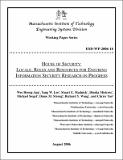| dc.description.abstract | In this paper we redefine information security by extending its definition in three salient avenues: locale (beyond the boundary of an enterprise to include partner organizations), role (beyond the information custodians’ view to include information consumers’ and managers’ views), and resource (beyond technical dimensions to include managerial dimensions). Based on our definition, we develop a model of information security, which we call the House of Security. This model has eight constructs, Vulnerability, Accessibility, Confidentiality, IT Resources for Security, Financial Resources for Security, Business Strategy for Security, Security Policy and Procedures, and Security Culture. We have developed a questionnaire to measure the assessment and importance of information security along these eight aspects. The questionnaire covers multiple locales and questionnaire respondents cover multiple roles. Data collection is currently in process. Results from our analysis of the collected data will be ready for presentation at the conference. | en_US |
